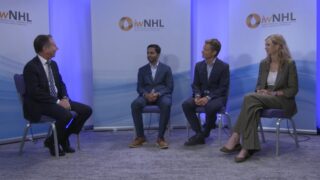The BP41072 study is a combination study for patients with relapsed refractory B-cell lymphomas, both indolent and aggressive B-cell lymphomas. It’s a combination of glofitamab, a bispecific CD3 and CD20 antibody, together with a bispecific co-stimulatory fusion protein called englumafusp alfa, which targets CD19 on the B-cells, on the tumor cells and 4-1BB ligand on the effector cells, predominantly here the T cells...
The BP41072 study is a combination study for patients with relapsed refractory B-cell lymphomas, both indolent and aggressive B-cell lymphomas. It’s a combination of glofitamab, a bispecific CD3 and CD20 antibody, together with a bispecific co-stimulatory fusion protein called englumafusp alfa, which targets CD19 on the B-cells, on the tumor cells and 4-1BB ligand on the effector cells, predominantly here the T cells. With this combination, we want to not necessarily deepen the responses to glofitamab, which are already frequent and deep, but we mainly want to prolong the responses. This is what the preclinical data promised and this is also what we see now both with the clinical responses and with the pharmacodynamic analyses which are presented here at ASH. So in a relatively large population of more than 130 patients included, we see overall responses in the vast majority of patients, including complete responses in 57% of patients. So it’s actually more than in an indirect comparison with glofitamab monotherapy in a similar population where the CR rates were 40%. Of course, it’s not a direct comparison, but it looks pretty promising. And these were heavily pretreated, quite sick patients, median prior lines of treatment of three, and the majority of patients being both primary refractory or refractory to the most recent treatment line, and that is for the majority of patients with aggressive non-Hodgkin lymphomas. So focusing on those, like I said, complete response rates of 57%. But if we look into the subgroup of patients, just about 50% with no prior exposure to CAR-T treatment so that’s about half of the patients the complete responses were much higher around 73% and if we look at the sorry not 73% that was the overall response rate but if we look at the population of patients with aggressive B cell lymphomas not exposed to a prior CAR T and treated with this combination in second line so comparable to the approved indication for standard CAR T’s now, we see complete response rates of 77%. So 10 out of 13 patients, and admittedly the numbers are low, had complete responses to this combination in second line. So really quite promising. And if we look at the durability of these responses, they are highly durable. So with a plateau of progression-free survival building at around 35-40% for all patients with aggressive non-Hodgkin lymphomas and with more than half of the patients reaching a CR, maintaining that CR for at least two years beyond treatment. So what about safety? You could imagine that a potent co-stimulatory molecule like englumafusp alfa would boost not only efficacy and durability but also cytokine release syndrome. Fortunately, that doesn’t seem to be the case. We see more or less the same safety signal with this combination as we do with the glofitamab monotherapy.
This transcript is AI-generated. While we strive for accuracy, please verify this copy with the video.















